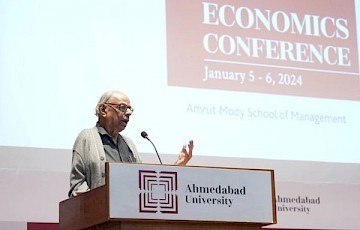22 December 2024
Economic Realities of India's Gig Economy and Policy Pathways

The gig and platform economy in India presents a promising picture. NITI Aayog's 2022 report placed the number of active gig workers at approximately 7.7 million in 2020-21, projecting a significant increase to 23.5 million by 2029-30.
These figures show a fundamental shift: freelancing is no longer a mere side hustle but a viable profession, offering new economic opportunities with lower overheads and potentially higher returns. This trend is particularly prevalent among young professionals. Through her research, Professor Jeemol Unni of Ahmedabad University's Amrut Mody School of Management provides theoretical and practical insights into this key sector.
Professor Unni's collaborative study with Professor Ravikiran Naik (FLAME University) reveals a stark contrast in economic precarity between gig workers and traditional employees. Traditional and digital workers face heightened economic uncertainty due to job fluctuations. Notably, gig workers often command higher wages, indicating a potential shift in service sector demand.
The study, Heterogeneity of Labour on Digital Platforms in India - Precarity or Empowerment? published in the Economic and Political Weekly, categorises digital labour platforms into web-based (remote, online work) and location-based (on-site service delivery). Building upon Professor Unni's earlier research on 'empowerment' within platform work – examining control, independence, and job security – this analysis focuses on the economic dimensions of vulnerability.
Further delineating web-based platform workers, the study distinguishes between digital wage/salary workers (fixed contracts or pay structures) and digital self-employed workers (entrepreneurs using platforms for sales). The research found that wage/salary workers often experience income instability and limited social security, whereas self-employed workers leverage platforms for wider customer access and infrastructure, leading to potentially higher earnings and greater economic stability.
During the budget presentation, Union Finance Minister Nirmala Sitharaman acknowledged the 'great dynamism' gig workers bring to the modern service economy, highlighting the sector's growing importance for policymakers. This recognition reflects the gig economy's undeniable influence on India's 21st-century economic landscape.
Gig Economy and Public Policy
The gig economy provides a compelling solution in an era defined by consumer demand for rapid, high-quality, and cost-effective services. As Finance Minister Sitharaman emphasised during the 2025-26 budget session, policymakers in a dynamic economy like India must acknowledge and adapt to this evolving workforce.
The gig economy's hallmarks – convenience, immediacy, and dynamism – necessitate a nuanced understanding of its diverse components. This research highlights that not all platform work is inherently unstable; some roles offer significant opportunities. By recognising these distinctions, policymakers and platform operators can develop fairer policies and solutions to improve working conditions, fostering a more inclusive and sustainable gig economy.



